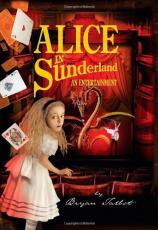Alice in Sunderland
Review
Alice in Sunderland
Brian Talbot’s Alice in Sunderland: An Entertainment, released in hardcover by Dark Horse in 2007, brought with it a redefinition of what graphic novels can be.
The comics narrative is usually thought of as fairly linear and direct in the way it tells stories, as it is predicated on the idea of sequential storytelling. Talbot’s Alice, however, absolutely reinvents what can be done in comics, breaking down both the fourth wall as well as boundaries that have previously confined creators within formal paradigms.
As both writer and illustrator, Talbot uses this enormous, 300+–page tome to take readers on a trip to Sunderland, England, which serves as a geographical focal point for his history of England, art, literature, and imagination itself, all while using the figure of Alice in Wonderland writer Lewis Carroll as a historical touchstone to help guide the direction of the book’s course. In order to achieve this goal, Talbot draws various versions of himself into the text, often speaking directly to the reader as he follows one narrative thread to another, weaving a tapestry of information and ideas that will leave those who give the book a try dizzy with the experience. If that sounds overwhelming, that’s because it is—but only in the best way.
Alice defies usual storytelling techniques in that there is no actual story or plot, per se. Rather, the book combines elements of theatrical performance with academic lecture, utilizing the stage in Sunderland’s real-life Empire theatre as the starting and ending points for the book’s meta-narrative. But the elements and traditional notions of story and plot do surface and resurface throughout in the forms of the Storyteller and the Traveler (two versions of Talbot himself), who tell Carroll’s story and keep the book moving along briskly.
The sequential storytelling technique of the book is perhaps one of the more interesting (and potentially frustrating) elements of the whole experience. While the book begins using sequential narrative grids, the borders between panels break down, and the panels themselves become little more than amorphous pictures that bleed and blend in with one another, with the dialogue boxes serving as your eyes’ guide for how to progress, though more traditional grids appear again and again. Instead of confusing readers, the looser narrative style simply feels free, offering a graphical representation of Talbot’s thesis: that people are all connected to one another by history, art, and our shared cultures, even when those connections may not seem clear at first glance.
Alice in Sunderland is nothing short of groundbreaking. Reading it is challenging, as the densely delivered information can leave readers feeling exhausted from simply trying to absorb and retain it all. The lack of a traditional story structure, too, may prove troublesome for those looking for a simple or relaxing reading experience. But the revelatory way in which Talbot weaves his “entertainment,” and the effect of artistic and cultural enlightenment it can provide to those up to the task, makes it a necessary addition to anyone’s library.
Reviewed by Brian P. Rubin on July 2, 2012
Alice in Sunderland
- Publication Date: April 10, 2007
- Genres: Graphic Novel
- Hardcover: 328 pages
- Publisher: Dark Horse
- ISBN-10: 1593076738
- ISBN-13: 9781593076733



